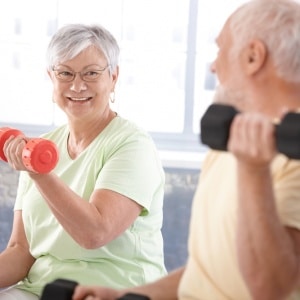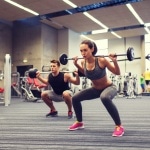 February 2022
February 2022
Body Recomposition for the Older Female
“Body recomposition” – a new term in the fitness science world – refers to the positive changes you get from an exercise program such as increased lean muscle mass (LBM) and decreased body fat (BF), both of which are favorable to health, not just appearance. This is a topic we’ve covered here, here, here, and here. Lately, much attention has looked at the role of protein intake. Whereas most health and nutrition bodies recommend 0.8 grams/kg of body weight, more recent data suggests that getting more than 1.0 g/kg might be more advantageous for older adults.
A multinational group divided the analyzed the results of six studies totaling 130 older (>60 yrs.) women who could be categorized as Low Protein (LP), Moderate Protein (MP), and High Protein (HP) consumers who’d participated in 24-week supervised programs of resistance training (3/wk, 3 sets x 8-15 reps.) LBM and BF were measured with DEXA scans, the gold standard.
The results demonstrated that MP and HP contributed to greater improvements in LBM and BF. Gaining LBM requires more calories and losing fat requires fewer so getting these seemingly-paradoxical benefits is a function of which macronutrients one consumes.
When more of those calories are protein, it is possible to decrease overall caloric intake and still gain muscle mass. Newer studies suggest they consume >1.6 g/kg; the average protein consumption in this cohort was about 1.3 g/kg.
We can conclude that older women can experience body recomposition if they are willing to engage in strenuous RT three times a week while eating almost double the protein most organizations recommend. A hard row to hoe but worth the health benefits, right?
MSSE Jan. 2022
Exercise is Medicine…Even Against Covid
Covid-19 hit the world in late 2019 and has disrupted nearly every aspect of everyone’s life these past two years. Much has been learned about risk factors that contribute to both contracting and having severe symptoms if you do get it. Early studies pointed to gender (males>females), pre-existing conditions (heart disease, diabetes, cancers, etc.), even body fatness (it seems fat cells themselves contribute to severity.) Presumably, since many studies have demonstrated that being physically fit enhances general immunity, those who meet national standards of physical activity (>150 mins/wk of moderate-to-vigorous PA) would have better outcomes in the event they contracted covid.
Using data culled from Kaiser Permanente (a large health care system in Southern CA), a study analyzed a cohort of 48,440 treated covid patients among their 15 medical centers to determine if their exercise habits impacted their outcomes. Average age was 47.5 yrs, 62% were female, and 65% were Hispanic. Mean BMI was over 31 which places them in the obese category.
They found that those who’d been fitter prior to contracting covid were ~70% less likely to be hospitalized and 80% less likely to die of it.
When they adjusted their data to account for ‘defined risk factors’, they found that exercisers were 2.26 times less likely to be hospitalized and 2.5 times less likely to die of it.
Even those who only did some exercise had lower risks for hospitalization and deaths. Add one more reason to exercise.
Br Med J 2021
Tid Bits
Modern, and inexpensive, technology can save your life if only you use. For those with hypertension, or high blood pressure, a store-bought blood pressure device costing as low as $40 allows you to monitor yourself right there at your bedside. But studies show that only 2/3 of doctor-recommended patients do so regularly and about half check it once a week. A morning check in is best. Focus on Healthy Aging Jan. 2022
During and after treatment for breast cancer, it is not uncommon for patients to lose lean muscle mass (LBM). This is associated with increased treatment-induced toxicity, faster tumor progression, and decreased survival. Whereas most studies on the benefits of exercise for breast cancer patients looked at aerobic exercise, a meta-analysis of 17 studies that included 1743 patients found a significant benefit of resistance training alone or added to cardio training during and after treatment. This included maintaining LBM at higher levels than did cardio training alone. MSSE Feb. 2022
Prior hamstring injury (HSI) is the best predictor of future HSI. For that reason, some have suggested doing hamstring strength and fascicle-length ultrasound (US) measures pre- and mid-season might guide an athlete’s training to prevent future HSI. Eccentric strength (the strength the muscle has in resisting a load vs pulling it) was measured using a Nordic hamstring curl exercise, deemed one of the best exercises for prevention of HSI. The US was used to measure the length of the main hamstring muscle fibers. They found that multiple measures really don’t offer superior predictive data than does a single pre-season test. What matters more is the ratio of strength: a 9% difference between the two hamstrings might predispose you to an HSI. MSSE Feb. 2022
















